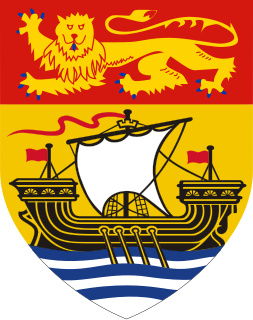For the 21st century New Brunswick politician see Ted Flemming (politician)
The Wolastoqiyik, or Maliseet, are an Algonquian-speaking First Nation of the Wabanaki Confederacy. They are the Indigenous people of the Saint John River valley and its tributaries, and their territory extends across the current borders of New Brunswick and Quebec in Canada, and parts of Maine in the United States. The Houlton Band of Maliseet Indians, based on the Meduxnekeag River in the Maine portion of their traditional homeland, are since 19 July 1776, the first "foreign" Treaty allies with the United States of America and a federally recognized tribe of Maliseet people by the United States. Today Maliseet people have also migrated to other parts of the world. Maliseets are forest, river and coastal people within their 20,000,000 acre, 200 mile wide, and 600 mile long Saint John river watershed homeland.

Riverview is a town in Albert County, New Brunswick, Canada. Riverview is located on the south side of the Petitcodiac River, across from the larger cities of Moncton and Dieppe. Riverview has an area of 34 square kilometres (13 sq mi), and a population density of 564.6 inhabitants per square kilometre (1,462/sq mi). Riverview's slogan is "A Great Place To Grow". With a population of 19,667, Riverview is the fifth largest municipality in New Brunswick, having a larger population than the cities of Edmundston, Bathurst, Campbellton, and Miramichi, despite its designation of "town".

Oxford is a town in Cumberland County, Nova Scotia, Canada 32 km (20 mi) east of Amherst. The town is directly serviced by Routes 104, 204, 301, and 321.

Chatham is an urban neighbourhood in the city of Miramichi, New Brunswick, Canada.
Daniel Hanington was a farmer, mill owner and political figure in the Province of New Brunswick, Canada. He represented Westmorland County in the Legislative Assembly of New Brunswick from 1834 to 1862.

Dalhousie is a Canadian town located in Restigouche County, New Brunswick.

Canterbury is a village in York County, in the Canadian province of New Brunswick. The village is located west of the Trans-Canada Highway at the intersection of Route 122 and Route 630. The mayor is Elaine B. English.

Chipman is a Canadian village in Queens County, New Brunswick.

This article is about a Canadian village. For the farthest point upstream where a river is affected by tidal fluctuations, see Head of tide.

New Brunswick, is one of the three Maritime provinces in Canada, and the only officially bilingual province (English-French) in the country. The history of New Brunswick can be viewed according to four periods: pre-European contact, French colonization, British colonization and finally, New Brunswick since Confederation.
Heron Island is a previously inhabited 7.15 kilometres (4.44 mi) long island in the Baie des Chaleurs, located approximately 4 km from New Mills, New Brunswick and across from Carleton-sur-Mer, Quebec. It is accessible only at high tide from a wharf on the south side of the island. Today the island has been declared a provincial reserve and is under the care of the New Brunswick government. There is a native traditional burial ground near the northwest end of the island.
Richard Bellamy (1825–1892) was a farmer, land surveyor and politician in New Brunswick, Canada. He represented York County in the Legislative Assembly of New Brunswick from 1886 to 1890 as a Liberal member.

Thomas Leavitt (1795–1850) was an early president of the Bank of New Brunswick in his native Saint John, New Brunswick. Leavitt was also a diplomat, politician and powerful Canadian businessman with interests in the shipping industry.
Steeves Mountain is a Canadian Community, located in Westmorland County, New Brunswick. The Community is situated in southeastern New Brunswick, to the west of Moncton. Steeves Mountain is part of Greater Moncton.
Route 128 is a provincial highway in the Canadian province of New Brunswick. The highway starts in Lutes Mountain as Homestead Road at Route 126. The road travels in a horseshoe pattern through two small communities before ending in the city of Moncton at an interchange with Route 15. In the community of Berry Mills, New Brunswick, the road is called Berry Mills Road and in Moncton, Route 128 is also designated Killam Drive.
Cails Mills is a community in the Local Service District of Weldford Parish, New Brunswick, located 4.26 km ENE of Bryants Corner and 3.83 km W of Fords Mills.
Jonathan Marsh (1621–1672) was a founding settler of the New Haven Colony, and of Norwalk, Connecticut. He came to Norwalk from New Haven sometime prior to March 1656. He was the settlement's miller.
Benjamin Milliken was an American Loyalist, major landowner, mill and ship owner in Maine in the Province of Massachusetts Bay, British North America. He was the founder of Ellsworth, Maine in 1763, laid out and received the land grant for the Township of Bridgton, Maine in 1765 and was one of the first settlers in Bocabec and St. Andrew's, New Brunswick in 1784.








